A Day in the Life of an ISyTE Camper
Monday, November 14, 2016
The following story tells the tale of a fictitious high school student attending Oklahoma State University’s “ISyTE” camp – an Information Systems Technology Exploration program hosted by the Management Science and Information Systems department in the Spears School of Business and the Center for Executive and Professional Development. The camp and people mentioned in this story are real characters being seen through the eyes of an Oklahoma high schooler. The narrator, Ariel West, attended the weeklong camp and blended in with the students to write from their perspective. All events portrayed in this story are factual.
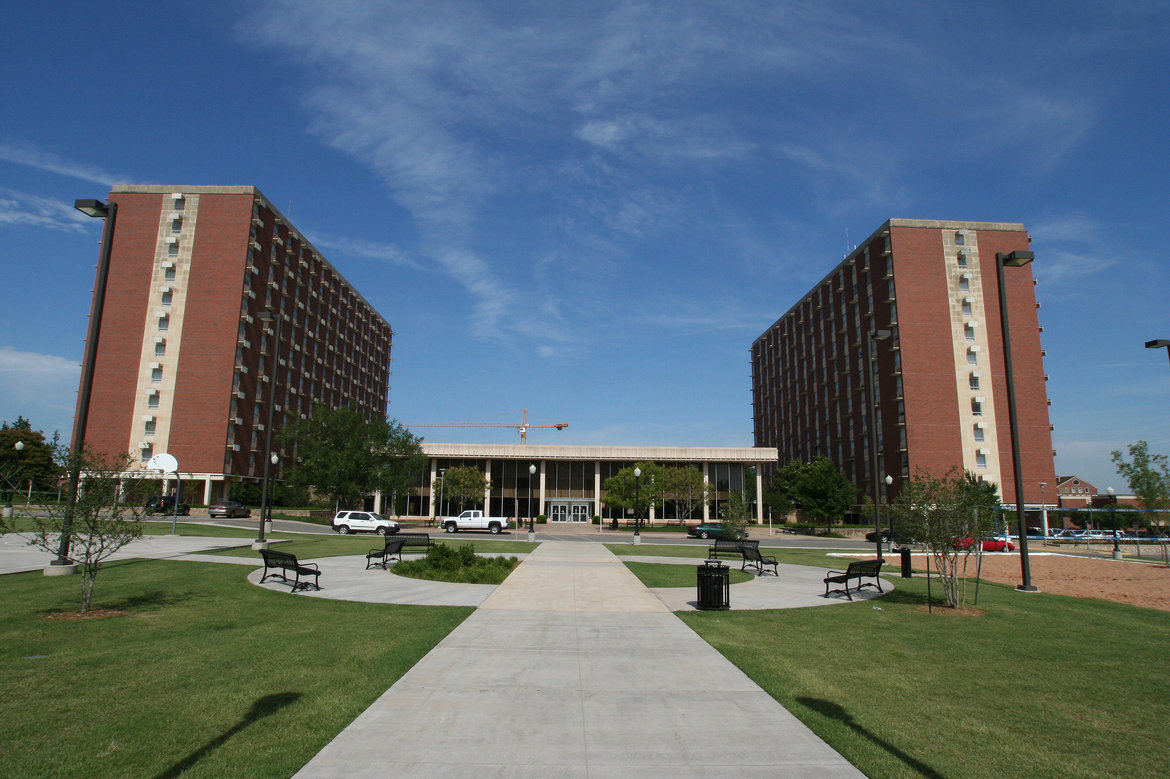
Day Zero: The Meet-and-Greet.
It was hot.
We pulled up to two buildings that towered over the campus on Sunday afternoon. You could tell it was June in Oklahoma with the way the sun could pierce through your clothes and still burn your skin. My parents unlatched the back trunk and we unloaded my bags for the weeklong camp at Oklahoma State University: Information Systems Technology Exploration. The camp was designed to give us high schoolers a peek in to the life of a college student pursuing a Management Science and Information Systems degree, and I was excited to get the week started.
After settling in to the dorm room I would be staying in for the week (how cool is that?), my parents and I headed to the meeting spot – a large mezzanine perched above the front desk of the Kerr-Drummond residence halls. I sat anxiously in my chair, taking in the college experience. Here I was, in an actual college dorm! There were a lot of other campers coming in, some quiet, some talking excitedly with their parents.
This was going to be the best week of my life.
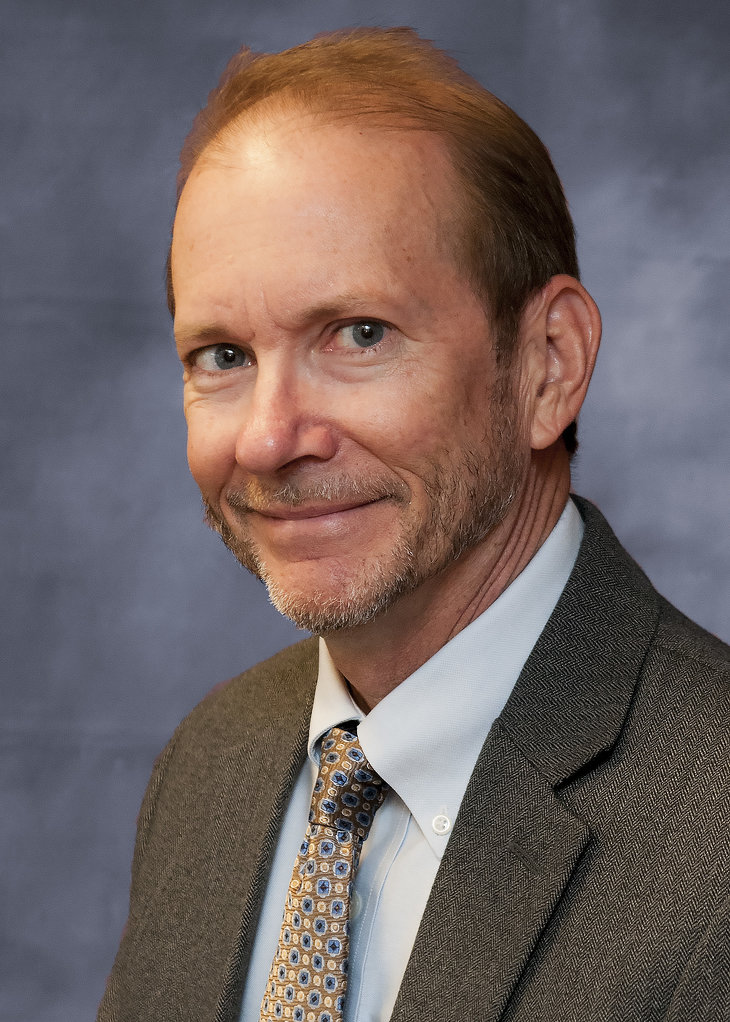
A man walked up to the front of the group, his smile happy and inviting. The noise in the room started to dissipate, and he nodded his head to us.
“Hello, and welcome,” he said. “My name is Rick Wilson, and I am the department head for the Management Science and Information Systems department in the Spears School of Business here at OSU. I know, lots of long titles. You can say ‘MSIS’ for short.”
I was already drawn in to his quirky personality.
“This is the 8th year of our weeklong summer camp, ‘ISyTE’ for short,” Rick said. “It’s a one-of-a-kind experience here because no other university in the nation has a program quite like this. I know this because they all ask me for tips on how to make their camps better. We are going to have a lot of fun at this camp, and we are going to learn about MSIS. It’s a business degree focusing on information technology in innovative ways to improve organizations.
“No, not all MSIS people work at Google, but that is one place you can find them,” he said with a chuckle. “All companies, including distribution, health, consulting, energy and many others, big and small, hire our MSIS people. MSIS is among the highest paid of graduates, and they have almost unlimited opportunities. Seven of the top 30 fastest growing jobs can be obtained with an MSIS degree.”
An almost guaranteed hire-rate and big money? Count me in.
“Oklahoma State has one of the largest MSIS programs in the region, my friends. This is the good stuff,” Rick said, thumbing through colored papers. “If you are a problem solver, like technology and can think strategically, MSIS is for you. There are many opportunities, you will be well-paid, and you will be a lifelong learner.”
“The camp will run for five days. We will take care of your child, promise – we haven’t lost one yet!” Rick said, which prompted chuckles from the crowd. “On Monday, they’ll be a part of team building activities and a ropes course at OSU’s Camp Redlands facility. Tuesday, we get to the meat of building a functioning computer and installing the operating system and networks required to run. Wednesday, they get a tour of Boone Pickens Stadium, OSU’s top-notch football facility, participate in a career workshop put on by OSU’s Career Services department, and then continue with building their computers with software and programming. On Thursday, we will get to hack a password-protected computer in the morning and then travel to ConocoPhillips, Phillips 66 and ONEOK in Tulsa to tour the facilities and network. We will wrap it up on Friday with some fun technology exploration, workshops and games before we have our recognition dinner. It’s a pretty full week of activities.”
No kidding. I got tired just listening to Rick talk.
“Now, parents, it’s time to say goodbye to your kids,” Rick announced. “Thanks again for being a part of our 8th year of this camp, and we are looking forward to showing them MSIS.”
I hugged my parents tight. It was going to be a long week without them, but I could already feel my heart racing with excitement. I knew it was going to be a great week.

Tomorrow is the outdoor activities and ropes course at Camp Redlands. I’m a little nervous; I didn’t expect to be doing outdoor activities at an MSIS camp. What could we be doing it for?
Guess I’ll find out tomorrow!
Day One: Camp Redlands.
Here I was, peacefully enjoying my sleep in my cool college dorm room, when it happened.
Loud yelling, banging on doors, feet trampling through the hallways. I shot out of bed, wide-eyed and frantic. Did something happen? Was the building on fire? My mind was fuzzy from sleep, but my heart was pounding. It took me a second, but I realized what it was: the camp counselors.
They were running up and down the halls, banging on our doors to get us up for the first official day of ISyTE. They sported athletic, casual attire and had their respective colored bandanas tied around either their foreheads or wrists, marking leadership of their tribe. I looked for the yellow bandana and found my counselor, Josh. I gathered with the other campers in the lounge area as they counted us off. After a quick breakfast, we were loaded onto shuttle buses and began our trek to Oklahoma State University’s Camp Redlands.
I didn’t expect the drive to be as long as it was.

When we arrived at the camp, we met Michael, our first Camp Redlands counselor.
“So, who knows everybody?” Michael asked.
I glanced around. Everyone was silent.
“That’s okay, because by the end of the day, you will.”
He put us in a circle and we began doing some fun games to get to know each other, which included calling out a name and tossing a ball in that person’s direction. It was slow going at first, but we all started to learn each other’s names and were able to cut our time down each round. We also made a map of the world by using ourselves as “pins” at certain locations in response to questions Michael called out. I think a personal favorite of the morning was “Tusker,” a game where one person starts out with two pool noodle toys and “eats” people. The Camp Redlands counselors told us that Tusker was a magical creature that used to roam the lands of the camp before the town of Stillwater was founded, and he would eat humans to grow bigger and bigger. Surely, it was just a story…. Right?

“So, tell us some things you learned today,” Michael said.
One of the girls in our group, Charlee Alsup, raised her hand slowly.
“We actually had to use critical thinking skills at this camp,” Charlee said. “We had to work together on a lot of parts, like the blindfolded shapes. Since we all had to make a triangle out of one big string, we naturally started to talk with each other to figure out who was going to be the corners.”
“Great, what else?” Michael asked.
Another girl, Shalyn Bowles, spoke up this time.
“The games have been a lot of fun. We had to cooperate and adapt to the challenges as a team,” Shalyn said.
Michael nodded. “Good, and you will use all of these skills in the real world, so take them with you when you leave here. It’s time for lunch!”
Sandwiches, chips and cookies were served for lunch. I sat down at my table with some of the other campers, excitedly chatting about the teambuilding activities. We were already growing to be friends, and it had barely been three hours. It was nice to be at a camp where everyone had similar interests; I really felt like I fit in here.
“I think this is the only time that I have enjoyed doing physical activity, and I’m actually doing pretty well,” Tama Church, a girl in my yellow bandana group said. A lot of us nodded in agreement.
We finished our lunches and headed down to the part I was dreading; the high ropes course.
The Camp Redlands counselors gathered us around to walk us through the safety rules and show us how to secure our harnesses. After a few minutes of practicing our switches, we partnered up and hit the course.
I’m not going to lie; it was pretty scary.

After scaling the pole, I steadied my breathing as I stood on the beginning platform, making a point to not look down. I had two ways I could do this: go left and chance the net, or go right and walk the cable line. I was scared, but I was also feeling adventurous. I leaped from the platform, hands outstretched, suspended in the air for only a moment, and grabbed the rope net. I held on for a moment, steadying myself and finding my footing in the holes. This wasn’t the time for breathing, not yet. I pulled myself across the net, constantly looking up to make sure my safety cables were securely fastened to the wires (even though I knew they wouldn’t slip), and reached out to haul myself up to the next platform. Now, I could breathe.
We were all completing the course at various speeds. I could see one of the boys, Rhys Coker, walking back from the end of the zip line already. He was the first one up the pole to start the course; he was pretty brave! I gritted my teeth and began the last part of my trek to the zip line, balancing on the cable, my faithful partner on the ground below me calling up encouraging words. It seemed like an eternity, but I made it to the zip line platform. A Camp Redlands counselor, Taylor Schooling, helped me undo my safety cables and began hooking me up.
“Are you ready for this?” Taylor asked.
I nodded quickly, still steadying my breathing from the balancing act I just performed.
He offered a smile. “Hey, the view is pretty great from up here.” And then, a quick push.
Wow. He wasn’t wrong.

We waited for the rest of the group to finish the course, and then we all gathered around our counselors. They asked us about the course and our Camp Redlands experience, and there was a unanimous consensus that the experience had been amazing.
“I liked the teambuilding activities and working on my communication skills,” camper Kyle VanDeventer said.
“Yeah, it really brought me out of my comfort zone,” another camper, Juan Trujillo, said. “I liked getting to know everyone.”
We loaded the buses and began our trek back to the OSU campus. I was exhausted, and it was only the first day! Tomorrow, we get in to the meat of the camp, which is all of the computer and technology sessions.
I can’t wait.
Day Two: Build, Connect, Install.
Finally, the day I have been waiting for.
We ate breakfast in the dorm lounge before making a lengthy walk across campus to the Gundersen classroom where we would be spending the rest of the day. We walked into the classroom and were met with destroyed computers – okay, they weren’t actually destroyed, but the parts were laid out on the tables in front of us.
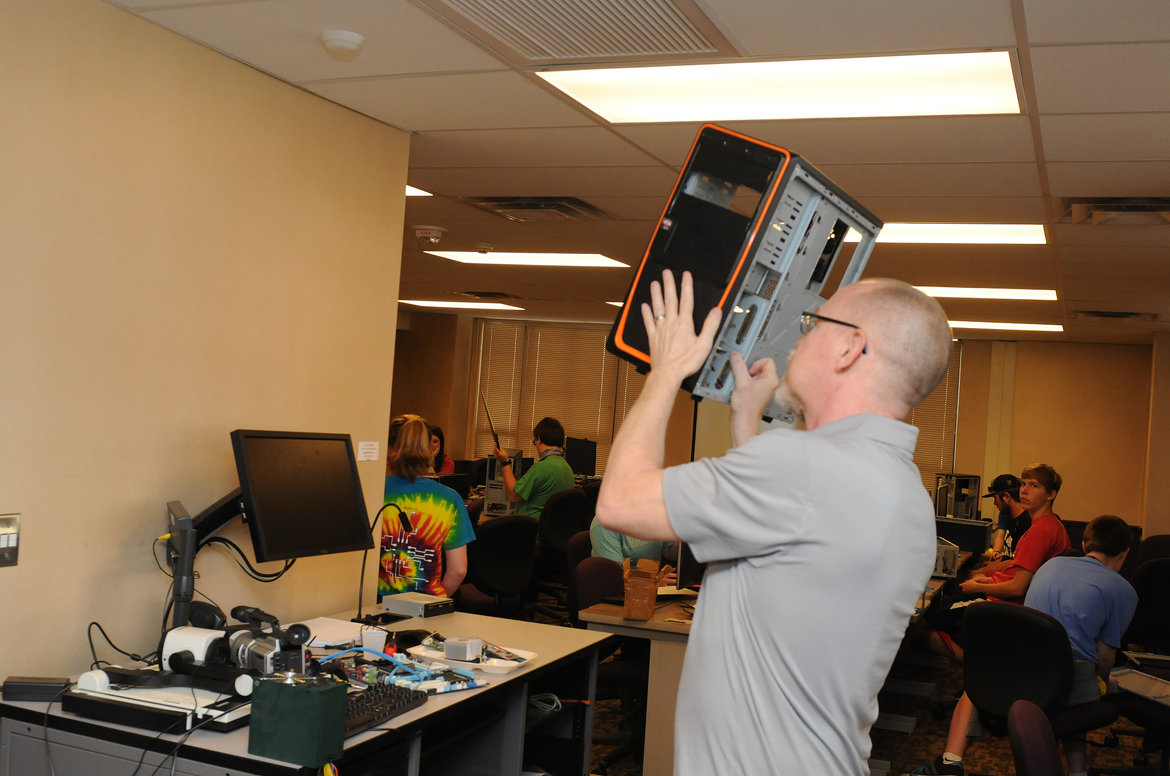
A tall man stepped up to the front of the classroom and gave us a casual wave.
“Welcome! I am Jim Burkman, I am a professor in the management science and information systems department, and we are about to do some really cool stuff,” he said.
I sat at my station and looked at all of the parts in front of me. It was a little overwhelming to see the computer’s “organs.” I was going to put all of this together? But there are so many slots and circuits….
“First thing’s first, wrist straps on,” Jim said. “We don’t want to short out the motherboard. That would be bad. Next, unscrew the computer case….”
We pieced our computers together slowly, and they started to look like actual computers. I carefully placed the motherboard into the case and screwed it in, placed the central processing unit (CPU) on the tiny pins in the center of the motherboard, put a heat sink fan on top of the CPU to pull the heat off, and placed two sticks of random access memory (RAM) in the slots on the motherboard. Jim called this the “Trinity.”
“We just put together the soul of the computer,” Jim said. “We call this the ‘Trinity’ in my house because these three components have to match: you can’t mix an Intel-brand CPU on an AMD-brand motherboard. It’s not gonna work out.”

Huh. Maybe this wasn’t so complicated. All that was left was to plug in all of the wires, which was pretty simple because the motherboard had where each wire should go written on it.
“Congratulations, you just built a computer,” Jim said. “Let’s take a break, and then another of our MSIS professors, Andy Luse, will walk us through how to install the operating system.”
I sat back in my chair and relaxed, not realizing how focused I had been. I looked over at a group of campers talking.
“Today has been the most interesting so far,” Ben Kelly said. “I had no idea how to put a computer together until now. I’m going to go home and open up my computer!”
“I already knew how to put together a computer, but I definitely learned some better ways to hook things up and arrange the cables,” Slayter Teal said. “I’ll probably go home and pull apart my computer, too.”
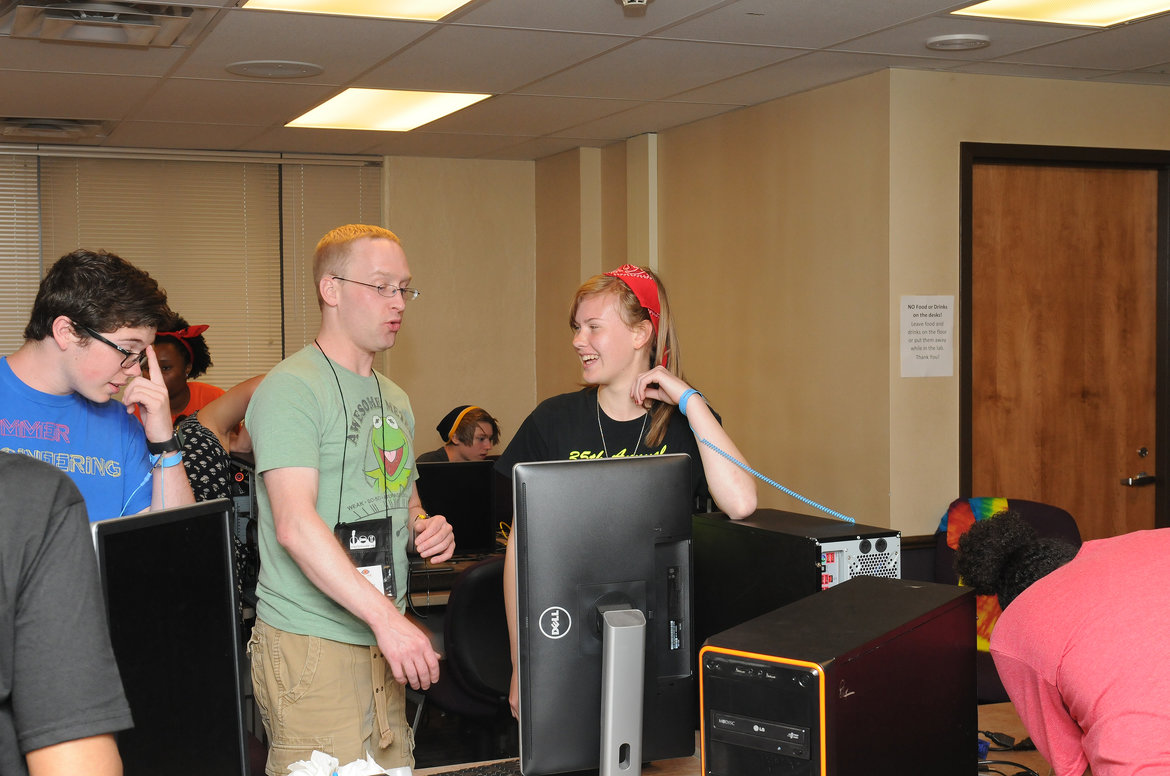
The noise in the room slowly lowered as a new face walked to the front of the room.
“I’m Andy, and I will be showing you how to install an operating system,” he said with a smile. “Grab the disks at your stations and place them into the CD drive and follow the prompts.”
This part was much easier. I followed the prompts, hit a few keys on the keyboard, and the Windows 10 screen appeared. Install successful.
“Easy, right?” Andy said. “Next, we are going to connect our computers to our very own network on the server….”
It took us about an hour, but we all connected and able to start “pinging” each other’s computers – that means we communicated to each other’s machines via network signals.
At the end of the day, we had a cook-out and played games at the dorms. At this point, all of us campers were just like old friends – you would think that we had always known each other!
Two days down, two more to go, I hear we get to play with some Raspberry Pi’s. What is a Raspberry Pi, you ask?
Beats me.
Day Three: Tours, Careers, Plug and Code IT.
With the daily round of our counselors acting like complete crazy people to wake us up for breakfast, our day began.
Today was going to be a little different. The technology parts of our ISyTE camp weren’t going to be until later. What could we be doing all morning, then?
Only some of the most amazing things ever – touring the Boone Pickens Stadium and Gallagher-Iba Arena and meeting Pistol Pete!

“My favorite part was learning about Pistol Pete and how he is based on a real person,” Aqeelah Rufai said during a moment to ourselves. “The museums were pretty cool, too.”
“I thought the same thing,” Luz Payan responded. “I just thought Pistol Pete was a mascot. It’s pretty cool that he was someone who was around back in the day.”
Next, we made the lengthy trek to the Student Union on campus. We filed into a conference room and were greeting by Lindsey Vallaster, the assistant director for OSU Career Services. She gets to help all of the OSU college students with their career ambitions. Sounds like a pretty cool job to me.
“Choosing a career requires you to think about all of the things that are important to you, not just your paycheck,” Lindsey said. “We are going to put you to the test to decide what you value in a future career and talk about some careers in Management Information Systems along the way.”
We were handed a list of 25 values and were told to rank them in order of importance. I began ranking values like “contribution to society,” “variety” and “creativity” at the top of my list and others such as “easy commute,” “prestige and status” and “power and influence” at the bottom. But we didn’t just get to rank our values – we had to bid on them.
“You have 5,000 points to bid on your values,” Lindsey said. “How much are you willing to spend on each value?”
It was cool to see what the other campers were willing to spend on each value. One camper, Alex Labbane, spent most of his points on “high earnings” and didn’t have enough to bid on other values. I was able to snatch “contribution to society,” but it was pretty contested. I ended up only getting one other value that wasn’t ranked as highly on my list. Lindsey then gave a brief overview of the jobs that would be available to us with an MIS degree: computer systems analyst, cyber security, database administrator, mobile application developer and many others.
We got to have lunch in the OSU Student Union, which was huge! There were so many food options to choose from: it had Mexican, Italian, American, coffee, smoothies and even a convenience store. I chose to get a slice of pizza and sat down with the rest of the campers in the atrium of the Student Union, which was an open space with tons of chairs and tables. It was a cool space – when you looked up, the ceiling was three floors above you, so the room felt very open and bright.
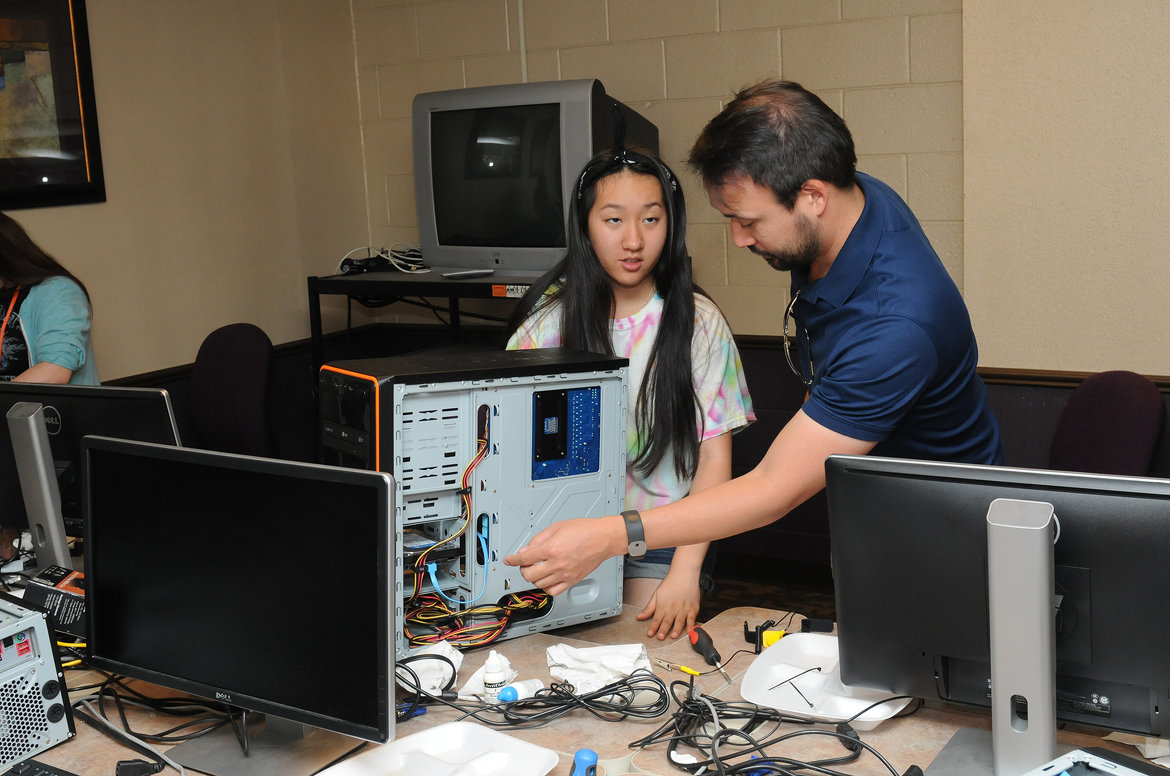
After lunch, we headed back to the classroom and took our seats at our computer stations. Now comes the fun part: setting up a Raspberry Pi. A Raspberry Pi is basically a single-board mini-computer used to supplement regular desktop computers. They were originally created to teach students about programming and technology, but a lot of people use them for fun, too.
“Hi, everyone. I am Bryan Hammer, and I am an assistant professor in the MSIS department here at OSU, and we are going to program our Raspberry Pi’s to do some cool things,” Bryan said.
We learned how to connect wires, a small lightbulb and a sensor to the Raspberry Pi. The sensor was used to pick up the color of an object you placed on top of it – I placed a piece of red construction paper on the sensor and my computer said (well, in text), “red.” How cool is that? The lightbulb could turn off and on, and we used a translator software to make the computer audibly “say” if the light was too bright or dark.
“You can do a lot with a Raspberry Pi,” Bryan said. “You can even use it to make your computer audibly respond to an input. Feel free to search for projects and try some out for yourselves.”

“You know, this camp has been the best camp I’ve ever been to so far,” said Tama Church as she finished off a plate of cheese fries. “Meeting you guys has been awesome. It’s nice being around people with similar interests.”
“I definitely agree,” Aqeelah Rufai said. “This camp has brought me together with some people I probably would have never met otherwise.”
ISyTe: bringing together technology and business one high school student at a time!
I wonder what day four has in store for us?
Day Four: Hack IT, Business Tours.
“RISE AND SHINE CAMPERS!”
I groaned and rolled out of bed around 7 a.m. as the counselors ran up and down the halls, banging on doors and shouting together. I didn’t know that I had signed up for a pep rally. It was just too early to be awake on a summer morning.

“Alright guys, it’s the moment you’ve been waiting for,” Andy said. “We are going to do some hacking today.”
I immediately perked up. Hacking?
“On the USB drives is a program called ‘Kali Linux.’ It is a penetration testing software for ethical hacking,” Andy said. “Developers, programmers and IT guys use this software to test for insecurities in their systems. We are going to try three different types of hacking with this software today. If you turn to your computer, you’ll notice you can’t log on.”
I turned to face my computer screen and noticed the log-in was asking for a password. I didn’t put a password on it.
“I went in and put a password on your computers,” Andy said. “Now, we are going to crack that password with Kali. Then, I’ll show you how to delete a password. This is the easy stuff, I know, but the fun stuff comes later.”
Cracking the password wasn’t that complicated. It’s easier to do if you have access to the physical computer, so it took most of us less thank 10 minutes to do. Deleting the password was simple, as well. I literally typed in a command and hit enter, and “poof!”
“See? Easy,” Andy said. “But, how often does someone actually have physical access to the computer they are trying to hack? Let’s learn how to get in to someone’s computer over the network.”

“Now, you can mess with the person’s computer,” Andy said. “You can look through their files, delete things, download things, take screenshots, anything you want. But let me be clear, it’s not always this easy. Many computers, especially if operated by someone who knows a lot about technology, will have strong firewalls and protections. They might even have anti-hacking software, which could turn out bad for you if you get caught.”
We closed out of the Kali Linux software and gathered our things. We were going on a field trip to visit ConocoPhillips and Phillips 66 in Bartlesville and ONEOK in Tulsa!
First, we traveled to Bartlesville to stop at ConocoPhillips. A representative from the company gave us a short presentation about ConocoPhillips and gave us a look into the lives of employees. They even fed us lunch! The fun part was testing the program the ConocoPhillips employees created. They sat us in front of computers and explained that we were each trapped in a different room of a giant house. Not only did we have to figure out how to escape our own room, but we also had to escape from the house together to get outside.
After, we headed to Phillips 66, where the company representative gave us a presentation about the company, as well. Then, we traveled to ONEOK in Tulsa and learned about the company and how technology has changed over the years.
We stopped at Incredible Pizza for dinner and games. I had a great time, but I was pretty tired from all of the tours and the hacking module.
I’m ready for bed.
Tomorrow is the last day of this amazing experience. I don’t think I’m ready for it to end.
Day Five: Explore IT, Workshops and Finale.
Is it really the last day of ISyTE?
The banging and cheering coming from the counselors outside of my door was almost muted as I stared up at the white ceiling of my dorm room. It really flew by.
I was tired from staying up late and waking up early, but I was really going to miss this place.
We had breakfast and headed over to a new classroom this time. This one has more open space in the middle with tables and chairs lining the walls of the room.
Huh. That’s interesting. Were we not going to work with our computers today?
A young, cheery man stood at the front of the room. You could tell he was excited; he was grinning from ear to ear and had a large box on the table next to him. What could possibly happen next?
And just when I thought I couldn’t be surprised anymore….
“I’m Zach Steelman, another MSIS guy here at OSU, and we are going to explore new technologies,” Zach said. “We are going to explore…wait for it…Virtual Reality.”
Is this real life? It’s actually not, because it’s virtual, but is this really happening?
“We have a piece of technology here for all of you,” Zach said. “It’s called ‘Google Cardboard.’ I know, it looks like cardboard, because it is, but you can use this to explore virtual reality games on your phone. You can even hook up a controller to your phone to make certain games easier to control. You guys get to keep these, too.”
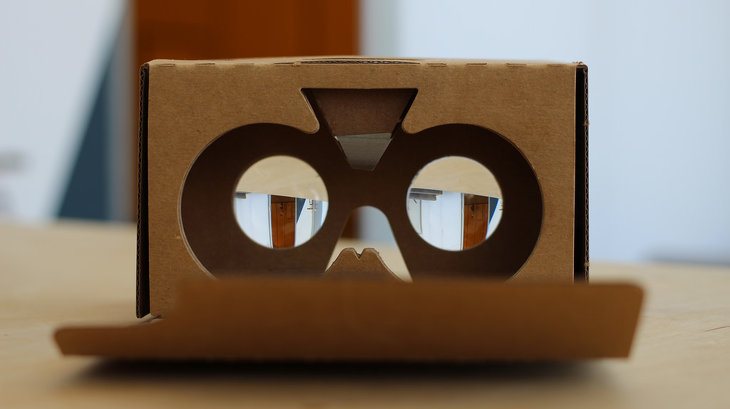
Zach passed out the Cardboard and booted up a PowerPoint slideshow to run us through the history of virtual reality, which has actually been around for a while but recent technology has made it more realistic. He demonstrated the Cardboard for us by plugging in his phone to the computer so we could see what he was seeing while using the Cardboard. It actually looked like he was in the game with a first-person view.
“There are a lot of cool games on the application stores on your phones currently, so download some and try it out for yourselves,” Zach said. “If you’re in to scary games, I recommend ‘Sisters.’”
Heck. No.
One camper, Aiden Moore, actually fell out of his chair using the Cardboard.
“It just came out of nowhere and freaked me out,” Aiden said.
Other campers were riding roller coasters, and some were watching videos.
“I’m literally watching Snoop Dogg in 3-D right now,” said Rhys Coker.
“I’m in a snowy cave,” Tama Church said. “There’s a plateau outside… oh, a fox!”
It was funny watching them react to the games they were playing. Some screamed, others laughed, and some had to put the Cardboard down because their game was too scary. I personally enjoyed a fantasy game I downloaded, where I was walking in a stone room trying to push a box out of the way of the door. It was a little complicated without a controller.
“This is by far my favorite part of the camp,” camper Alex Labbane said. “The horror games are actually scary. You laugh watching other people get scared, but then you try it for yourself and see how realistic it is.”
“Yeah, it’s cool, but I wasn’t completely comfortable not being able to see where I actually was in reality,” another camper, Benjamin Kelly, said. “I could have tripped over my chair or something. I guess that’s why people designate a space for virtual reality when they try it.”
Katie Norris, and academic counselor in the Spears School of Business, walked it on us trying out the Google Cardboard. I think she was a little confused.
“Hello everyone. I am Katie, and I will be presenting a workshop on college enrollment and some tips to help you get in to college.”
She went on to explain the importance of grades and attending any college fairs we could. She made sure to mention that we take an official campus tour of the colleges we were interested in to get insight on the college and its personality. She gave us tips on the college application process, choosing a major and financial aid services available. It put applying to college in perspective, because a lot of the time students are not really sure how the process goes from the college’s standpoint. It was cool to get the inside scoop on how college actually accept students.
After Katie’s presentation, we winded down the rest of the day by playing MSIS Jeopardy to review everything we had learned during the week. Then, it was time to head to the dorms to pack up our things.
I was actually sad I was going to leave this place.
I packed my few belongings and sat on the edge of my bed, looking around at the place I called home for a week. I learned so much about technology and business, and I really think it helped solidify what I wanted to do with my life.
Don’t cry. Don’t cry. This was a happy experience, I told myself.
Finally, it was time for the recognition banquet.

The campers and their families all trickled in to Click Hall, a large banquet room in the ConocoPhillips OSU Alumni Center on campus. We were served excellent food (and cookies!) and were able to mingle with each other before the awards banquet. The department head of MSIS, Rick Wilson, wasn’t able to be with us tonight, but he left us an amazing video.
“I want to start by thanking all of the faculty, support staff and camp counselors for helping put on an amazing week,” video-Rick said. “These are truly some of the best-of-the-best that your children got to learn from this week.
“Second, I want to make you all aware of our ISyTE promise as you depart from this week. The ISyTE promise is this: as an ISyTE campter, if your son or daughter is admitted to OSU and declares a major in the Spears School of Business in the MSIS department, he or she will be guaranteed an ISyTE scholarship. Our corporate friends are so committed to what we are doing that this is an automatic scholarship that is renewable every year as long as the student declares a major in the MSIS department.”
My eyes widened. I could feel my parents’ excitement beside me, almost like a static shock. I felt hugely grateful and honored. I didn’t expect this when I signed up.
“We’ve hope you had a great week, campers. Jim, it’s back to you,” video-Rick said, and the broadcast ended.
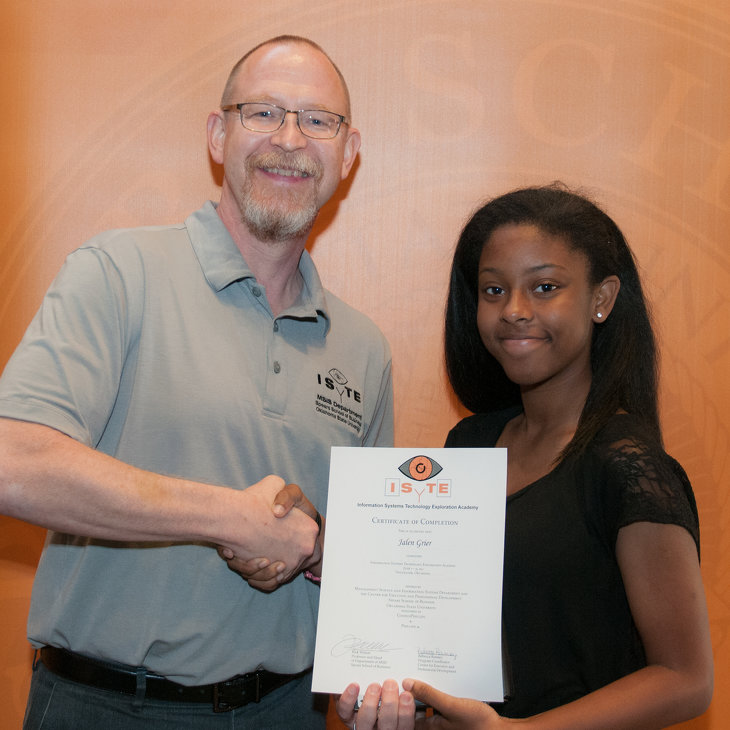
Jim Burkman stood up, thanked everyone for being here and began calling names to hand us our certificates of completion. And, of course, another huge surprise: we were presented with the Raspberry Pi’s that we had built!
I walked up to the front of the room as my name was called, extremely excited and nervous and humbled all at the same time. I shook Jim Burkman’s hand and received my certificate and Raspberry Pi, posed for a picture and walked back to the table I was sitting at with my parents and some other campers.
This was really it.
The rest of the names were called but were a blur to me as I reflected on my week. I started out on Sunday evening not knowing anyone around me and grew in my knowledge and social skills until the clock ticked to this moment – the end of an amazing camp.
I hardly noticed climbing in the car with my parents and buckling my seatbelt.
“Honey?” my mother asked. “How was your week?”
I shook the clouds from my head and responded with a smile.
“I think I know what I want to do with my life.”





